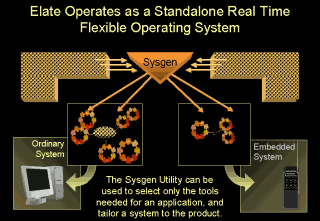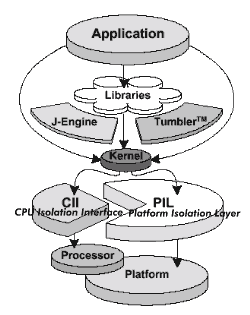
Kontakt
Treiber
Mp3 Soft/Suche
Download-Zone
Zone 2000
Kleinanzeigen
![]()
Fun Time Forum
Amiga-Club Forum
Amiga Forum
![]()
Seite eintragen!
Clubs
Development
Firmen/Companys
Hardware
Händler/Dealer
Magazine
News
Scene
Software
Spiele/Games
![]()
ElateRTM

Amiga kündigte Heute eine strategische Partnerschaft mit der Firma Tao Group an. Leider kann man der aktuellen Pressemitteilung nicht viel mehr entnehmen. Was Amiga nun genau von Tao haben möchte kann man nur erahnen. Dabei kann es sich eigentlich nur um das Betriebssystem ElateRTM handeln.
Sehr viele Anwender haben Probleme mit dem Gedanken sich an ein neues Betriebssystem gewöhnen zu müssen. Das wundert mich eigentlich. Als PowerOS, MorphOS oder damals pOS angekündigt wurden gab es eigentlich keine Proteste. Mir wäre auch das Original lieber. Leider lag das AmigaOS viele Jahre im tiefen Schlaf und das läßt sich nicht so schnell nachholen. Tatsächlich weiß man aber noch garnicht was die neuen Besitzer planen, alles ist möglich. Ich denke das sich Bill McEwen und Fleecy Moss alle Möglichkeiten durch den Kopf gehen lassen werden. Als zweites Standbein wäre das AmigaOS garnicht so schlecht, sofern dabei keine Verluste entstehen würden.
Viele fragen sich auch wieso Bill McEwens Entscheidung ausgerechnet auf ein ähnliches Betriebssystem wie QNX fällt? Das ist einfach zu erklären. Er verfolgt einen ähnlichen Plan wie schon damals Jim Collas. Die Firma Gateway und Amiga haben den Markt genau studiert. Auf viele der Statistiken von Gateway hatte mit Sicherheit auch Amiga Zugriff. Schon seit Jahren sprechen die Firmen nur noch von dem vernetzten Haus. Genau dorthin wollte Jim Collas gelangen und jetzt sieht die Sache nicht viel anders aus. Dafür wird aber ein flexibles Betriebssystem benötigt. Ausgerechnet Firmen wie Microsoft, Apple und andere Größen haben sowas nicht in der Hand. Selbst das AmigaOS ließe sich nicht in absehbarer Zeit dafür vorbereiten. Mit dem Betriebssystem von Tao stehen dagegen alle Möglichkeiten offen. Den Kernel von Elate kann man für alle Produkte entsprechend anpassen. Damit ist das Betriebssystem für Embedded Systeme (Kameras, Telefone u.s.w) und Computer einfach perfekt. So kann die Firma Amiga wie schon früher zur Jim Collas Zeiten angekündigt, Computer und gleichzeitig eine Reihe von anderen Geräten anbieten. Über ein Netzwerk können diese dann untereinander Daten austauschen.

Elate bietet auch gleichzeitig Java Unterstützung, die nach angaben der Firma zu den schnellsten und mit 2 Mbyte kleinsten gehört. Schon jetzt unterstützt das Betriebsystem zahlreiche Prozessoren und läuft sogar auf bestimmten Betriebssystemen drauf. Auf andere Systeme läßt sich Elate unoptimiert innerhalb von 2-3 Wochen portieren. Für eine optimierte Version benötigte man schon drei Monate. Vielleicht wäre dann auch eine Version für den Amiga möglich? Entwicklertools sind ebenfalls vorhanden so das man bereits jetzt dafür entwickeln kann, in Sprachen wie C, C++ und Java. Der Basic-Kernel hat eine Größe von 12 Kbyte.
Ich kann es deshalb verstehen wieso die Entscheidung gerade auf dieses System gefallen ist. Natürlich muß dann auch noch sehr viel getan werden. Dazu zählt ein guter User-Interface, das von TAO ist zu schlicht was mich glauben läßt das Amiga darauf verzichten wird. Entsprechende Mulitmedia-Erweiterungen fehlen dann auch noch und noch vieles mehr. Noch ist Amiga lange nicht am Ziel und ob es da auch ankommen wird läßt sich jetzt noch nicht sagen. Die Konkurrenz schläft nicht und der Gedanke das auch Sony einer der Investoren bei TAO ist beruhigt mich keinesfalls.
 Hier noch die Liste mit den Features von ElateRTM
Hier noch die Liste mit den Features von ElateRTM
Copyright der Liste aller Grafiken liegt bei Tao Group Limited
Elate is a new generation of networked real-time operating system. It can also operate as a run-time engine which can sit on
top of third party operating systems. Elate has been designed to be the main engine for digital appliances in mobile and home
networks. It is the only workable solution for providing a consistent infrastructure operating within industry standards on which
technology manufacturers can build a corporate strategy with superior branding and ease of use, high performance, minimal
usage of memory, fast time to market and many other fundamental attributes.
Elate offers binary portable systems. It achieves its portability by compiling all code to a single virtual processor without regard
to the target hardware platform. A translator tool is needed to convert the portable code to the native code of the target
processor ready for execution. Translators exist for most of the microprocessors selected for appliance programmes today.
New and efficient translators take just a few weeks to write.
Elate's streamlined binary code, VP code, is based upon thousands of modular tools. Using these it is possible to program in an
object-based manner. With Elate's object-based tool approach it is not necessary to load an entire class into memory in order
to use a single method from it; tools can be dynamically bound as and when they are needed. Storage overhead is further
reduced by the code density of VP code, which often takes up less space than the native code into which it will be translated.
Elate's tiny footprint, portability and high performance make it an ideal software solution for home and mobile networks.
Advantages of Elate
Portability
- Kernel and libraries portable
Flexibility
- Can run standalone or on top of legacy operating systems
- User configurable kernel
Compact
- Basic kernel may be as small as 12KB
- The JBC Engine is fully supported by an Elate
- Operating System of only 300KB
Object Based
- Possible to build classes and other object oriented features using modular, reusable tools
Multiprocessing
- Elate supports heterogeneous multiprocessing
Multimedia
- World leading graphics capabilities
JavaTM Support
- JCK tested J-Engine
- Fast and memory efficient
- All the functionality of PersonalJavaTM 1.1 in only 1.5MB
Security
- Threads and memory managed by the OS
- New fast TumblerTM encryption technology

Features of Elate
Platform and Processor Independence
- CPU Isolation Interface (CII) and Platform Isolation Layer
(PIL) the only platform dependent features of Elate.
- PIL contains Platform Isolation Interface and platform
specific device drivers
Translation
- Use of translation means no ongoing run-time penalty
- Translation can be static or dynamic
- C and C++ compilers available
<Ü>
Range of Ready-Made Toolkits
- Selection of ANSI C libraries and POSIX functions
- Graphics and windowing toolkits
- Sysgen Utility Binds required tools into single image
Compact and Powerful Shell